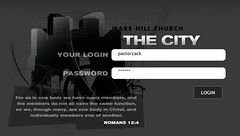
Found some more info on Mars Hill’s social network, The City:
The site is being built around physical communities not as much as around online communities.
One of the design principles of The City, which has guided virtually every decision we’ve made, is that the physical is more important than the virtual. This subtle but significant difference provides the foundation for understanding how this new thing is going to work…
On my Facebook page, I’ve got dozens of friends. Of those friends, I would imagine that about one third are actually in the Seattle area. The other two thirds are people literally all over the world. While there is a certain cool factor in having a virtual Rolodex of everyone I’ve ever known, is there anything more to it than that? Sure, if I’m planning a trip out to one of the areas where they will be, it’s rather convenient, and I get to find out that my college friend is eating a ham sandwich (a la Twitter), but that doesn’t change my life or their life for that matter. When you’re trying to build an intentional community, Facebook just doesn’t cut it. There are too many off topic, off mission sorts of diversions that the game aspect of the site dominates any mission it could try to carry.
Now, Facebook can be incredibly missional for the 1% that choose to use it as a mission field and network specifically with that in mind, but I’m trying to think along the lines of how you get the 80% to that level. The framework will either make a compelling community, or it will not. I don’t believe Facebook ever will do that for the 80%.
More specifically they’re building the site around physical neighborhoods.
Simply, your neighborhood is everyone that lives near you. Pretty basic eh? So why is this a cool concept? Let’s look at a concrete yet fictional example.
John is a community group leader in Ballard; he hosts his group just a little down the road from the public library off Market. He’s got a relatively new group with just five folks in regular attendance. He invites people to his group regularly, but they live all over the place! Ballard draws people from all over Seattle (and beyond), and finding the right people has been tough.
Jim is new to Mars Hill. He attended his first service, stopped by The City kiosk afterwards, and signed up to be “connectedâ€, whatever that means. The volunteer that helped him was nice enough, but Jim doesn’t know what he’s supposed to do next. He lives near the old firehouse on Market, in fact, he works as a Brazilian Jiu-Jitsu coach at the studio there. If only John knew Jim was in his backyard…
This is where the ‘neighborhood’ thing I checked into the code this morning comes into play. John would see in The City that a new guy showed up in his neighborhood (without having to dig for it), maybe The City would even say, “hey, you’re the closest community group!†and John could reach out to Jim with a couple of clicks.
Love it!
Like this:
Like Loading...

